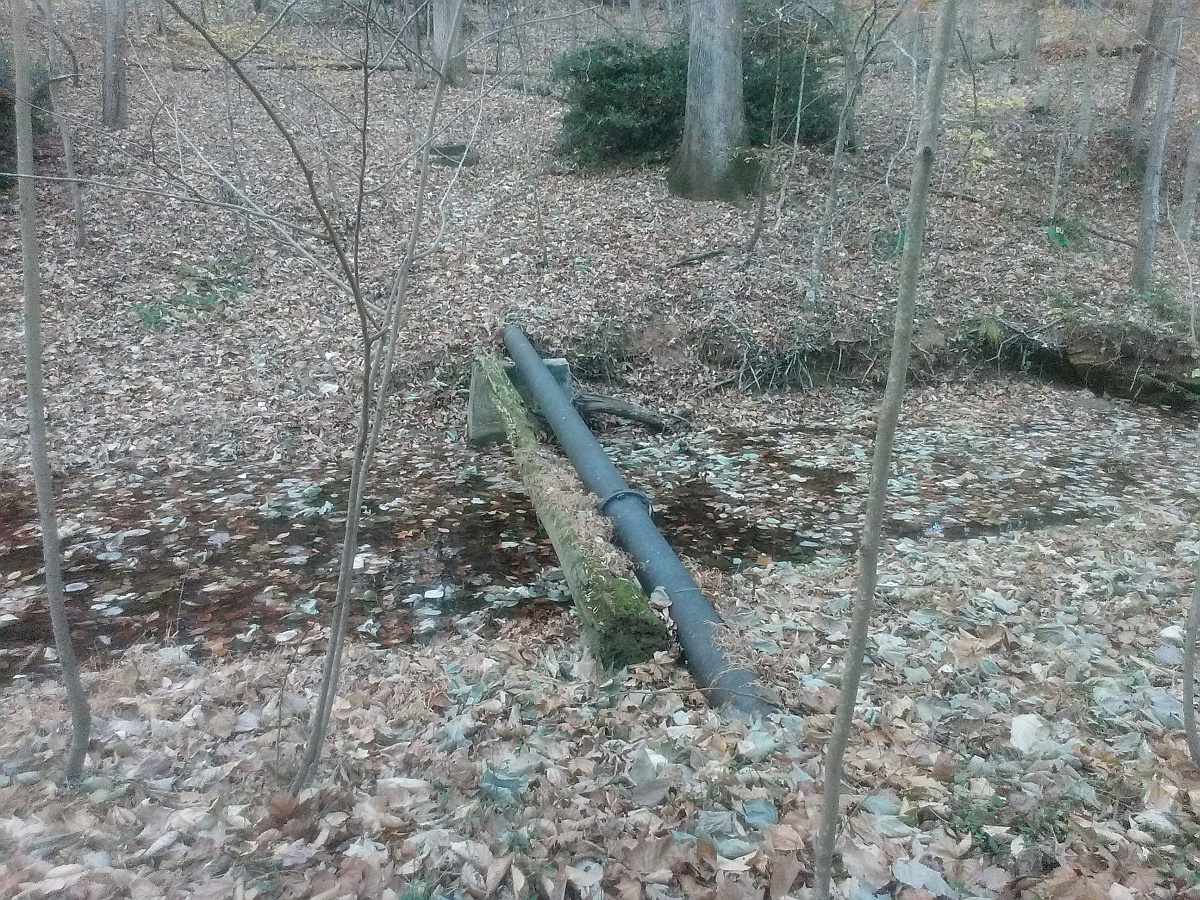Today was the perfect day for focusing on bringing down my blood pressure, which, despite a daily regimen of Losartan HCl, has crept upward to levels I can't sustain (though the amount of butter and salt in some of the day's feast might not have been quite the recipe for vascular health). I'm at my mom's in Martinsville more than frequently, yet I rarely get out and about visiting my old haunts except on holiday visits. So, this evening, after the Big Eat, I hoofed it around some of the woods in the neighborhood that are thankfully still intact after all these decades. As a wee youngster, those woods were a source of both wonders and nightmares, for in those days there were things out there that made strange sounds, that kept me awake at night, that surely watched me from the shadows with anything but benevolent intentions.

|
|
A massive, five-trunk Ghostwood that towers over the surrounding trees |
Down in the valley along Indian Trail, there's a meandering creek where I frequently played (and where I once managed to step, barefoot, into the shards of a broken bottle, resulting in a passel of stitches and some of the worst physical pain I've ever known). I encountered my first copperhead down there, which, in its anger at being disturbed, pursued me for what must have been many miles up the street. Around age eight or nine, I happened upon an injured opossum stuck in a mire; at first, I noticed only its thrashing tail, which I thought was a snake. "Snake!" I yelled in warning to my little brother. Then, when I realized it was actually a critter with burning red eyes and great big tuskies sticking out of its mouth, I hollered, "No, it's an armadillo or a rat or a pig or something!" This one didn't like me any better than the copperhead had, but at least it didn't chase me. A bunch of us kids used to play army down there, in an area that was greener and lusher than any of the rest of the woods, and that we called "Vietnam." I wouldn't be surprised if, somewhere down there, the remains of countless plastic model tanks that I set on fire and blew up with firecrackers are buried and awaiting excavation. There's something of gorge across which lots of fallen trees made handy bridges, though if my parents had known we were crossing them at admittedly dangerous heights, they would have killed me dead, such that I could not be writing about them all these many years later. This particular spot we called The Spider Pit, after the ravine in the original King Kong. I'm pretty sure that real dinosaurs lived there.
As a history buff, I would love to know more about the actual location. Along the hillside, paralleling the residential street, there are remains of what was once a road of some sort. In the years before I was born, it was clearly part of a large farm, and even when I was a youngster, there was an old, abandoned horse's stable (I seem to recall the horse's name was Frankie) and a wooden bridge across the creek, both now long gone, although one rotting beam of the old bridge remains. The story went that, as the horse was crossing the bridge, either the bridge collapsed or something caused the horse to fall, but in any event, the horse died. Other kids told me that, at night, you could still hear the horse crying out, and though I listened for it, I never heard any such thing. Alas! Many years ago, either from something I read or was told, I gathered a spur from a rail line ran through this area, which possibly could account for the cut along the hillside. But this is mere speculation, and I'd have to do some serious research to learn about this immediate area in the days before I lived here. The most famous local legend is that of Sam Lions, a slave from pre-Civil War days who escaped a heartless landowner, who eventually had him killed. One of the roads in the neighborhood is named for him. An account may be found here: The Legend of Sam Lion
As I was heading home, I came upon a massive flock of turkey buzzards settling into the trees for the evening behind Lakemont Court. I made a video, though it doesn't capture the magnitude of the sound they made — hundreds and hundreds of the huge scavengers, their wings beating and rustling, the trees alive with them, limbs thrashing beneath the weight of the interlopers. If one weren't aware of what was actually making that noise, one might think the sky was falling.
Thus draws another Thanksgiving Day to its close — gratifying, relaxing, stimulating. And it's put me right where I needed to be to get to work on my next terror tale. Scary? You betcha.
Happy Thanksgiving to one and all.

|
|
All that remains of Frankie's Bridge. In all my years here,
unfortunately, I never heard the crying of a ghostly horse. |

|
|
The area that I used to call "The Spider Pit," after the ravine scene in
King Kong. There were always trees fallen across the gorge — obviously not the same ones seen here, 40+ years later. |

|
| All that remains of what might have been a road or rail bed from the days long before I was born. |

|
| The mouth of a little underground channel at the creek along Indian Trail |

















